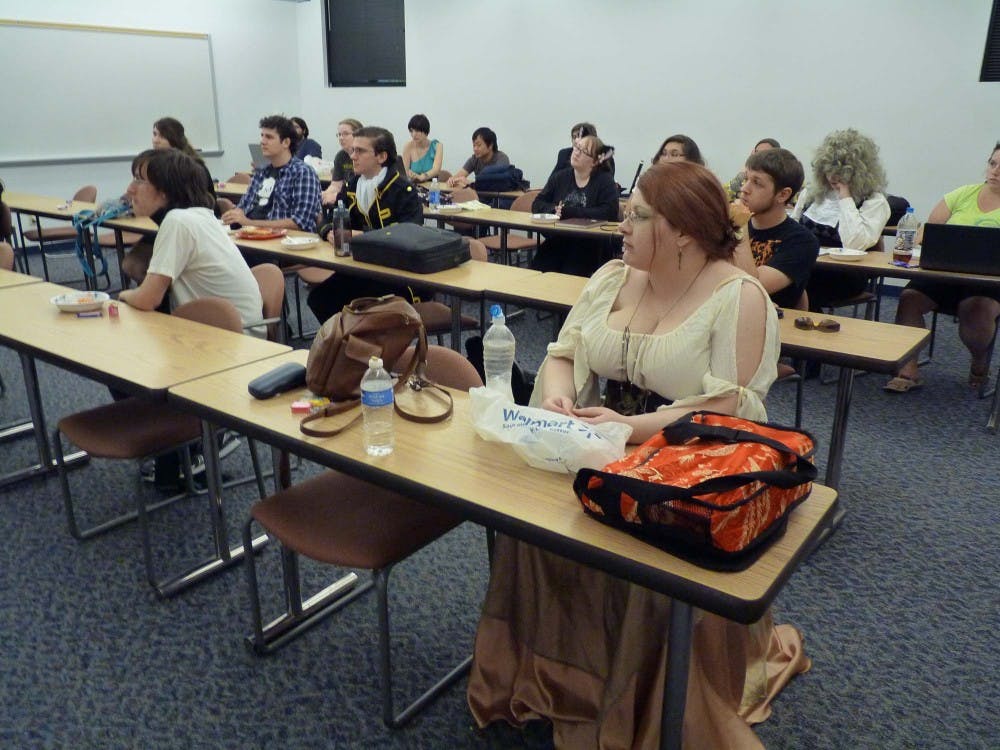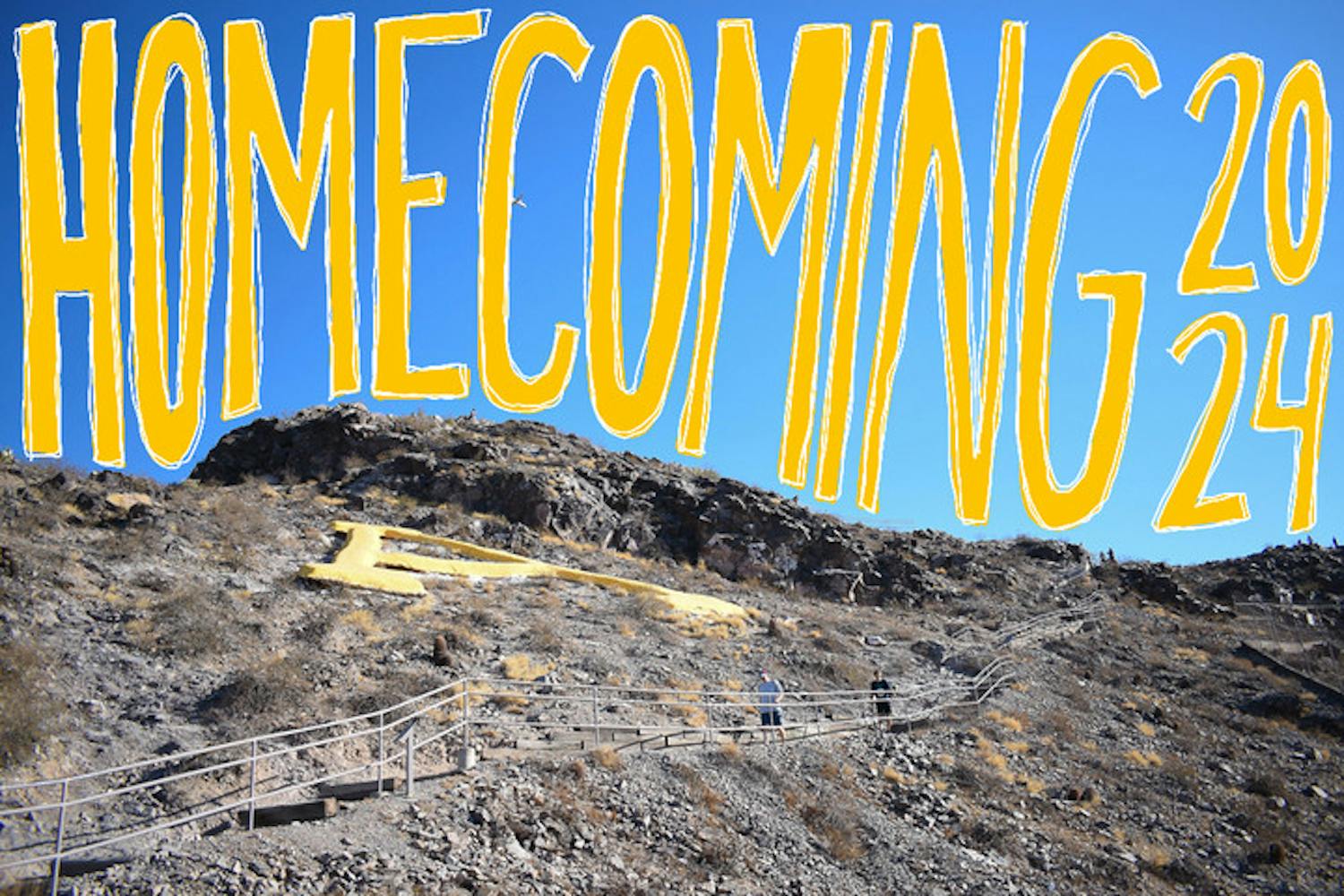 Dressed as a vampire at the Halloween meeting, Miranda Cunningham displays her love for anime.
Dressed as a vampire at the Halloween meeting, Miranda Cunningham displays her love for anime.Photo by Harmony Huskinson.
It is a tranquil Friday afternoon on the ASU West Campus—crisp autumn air mingles with afternoon sunshine, and birdsong emanates from large, shady elm trees next to buildings that frame a large, empty courtyard.
But from inside one of the seemingly peaceful buildings blasts the music and dialogue of a country thousands of miles away, within a different cultural mindset.
The chaos of 13 voices reverberates through the nondescript room as students in the ASU West Otaku Club laugh at an animated program, or anime, called “Umineko no Naku Koro Ni.”
They are in Japan, but not really.
While other guys and gals of ASU ready themselves for an evening of binge drinking and shameless partying, these students will spend their evening surrounded by the things they love—eastern Asian culture and wonderful friends.
These passionate fans meet every Friday to appreciate the popular culture of eastern Asian countries like China, Japan or South Korea. Members gather around a cluster of food, board games, manga (Japanese comics), anime, video games and music for three hours to discuss the failings of Naruto as a character, the nostalgia of “Sailor Moon,” or the attack stats of their latest Pokémon.
Beyond these weekly forays with other members, the student organization aims to raise awareness of eastern Asian cultures with the general public, says club president and psychology senior Katherine Riedel.
“It’s an opportunity to grow as a person,” Riedel says. “If you don’t expose yourself to other cultures you’re really missing out on everything that humanity has to offer.”
According to “Save the Geeks” by Joseph Tobin, an otaku in Japan loves Japanese pop culture—anime, video games, music—at an obsessive, unhealthy level.
Japanese society portrays an otaku as someone who only leaves their home to shop for groceries, someone whose social skills have atrophied to dangerous levels.
But American society has adapted the term to apply to any type of geek, Tobin writes, so that the word otaku no longer holds a negative context in the West. It has expanded into a general term for a nerd. According to Tobin, someone can be a “Star Trek-otaku” or a “Lady Gaga-otaku,” but the term usually refers to someone who loves anime or manga.
The club co-founder, Sherri Dower, says she started the club in 2005 to share her lifelong love of Japanese culture with the general public. She and her friends decided on the phrase otaku in the club name because they wanted to establish a positive message.
But several members of the Otaku club say that fans of eastern Asian media still receive the stereotype of a fat adolescent lazing in their mother’s basement by the glow of anime on television screen.
 ASU alumna Leah Winegart sits in at The Otaku Club Halloween meetings dressed in Renaissance garments.
ASU alumna Leah Winegart sits in at The Otaku Club Halloween meetings dressed in Renaissance garments.Photo by Harmony Huskinson.
“It can have that stigma associated with it. However that’s not the intention of our name at all,” Riedel says. “We’re not that obsessive. We’re a more open, very casual club.”
The club has existed for seven years through the leadership of seven different presidents. Despite varying levels of organization, student engagement, community involvement and meeting structure, the club has managed to survive a college environment where many student organizations fade away after the club founder graduates.
In its early days Dower says the club struggled with low attendance. But today members of the club come from all interests and backgrounds, Riedel says, which keeps attendance high at about 25 people per meeting.
Some club members travel from the Tempe and Downtown campuses, while others are alumni and regularly attend for years after they graduate. Dower sometimes pops into meetings on occasion, to check on the club and stay remembered as a part of its culture.
Not East culture, that is, East-loving West culture—on the West campus.
The ASU West campus does not convey the same sense of commotion and action as Tempe. Its Fridays are quiet, peaceful affairs, compared to the weekend buzz that envelops the Tempe campus on a Friday evening.
But Riedel says this smaller-scale provided the opportunity for a strong community.
“Finding that place where you can just be yourself and not have to worry about it is really important,” Riedel says.
Alumna Leah Winegart transferred from ASU to Western International University in 2007 and has since graduated from school, but still comes back to Otaku Club meetings because she values the sense of friendship and the opportunity to share her love of eastern Asian culture with others.
“This is my social outlet. It’s just my idea of fun,” Winegart says.
Every week is a different theme in anime or eastern Asian culture, like live action or video games. This week is Halloween, so the costumes and food abound.
 During the week of Halloween, Kristal Melton brought out her whiskers and cat ears ready to let the stresses of the week fade away while allowing her love for anime surface.
During the week of Halloween, Kristal Melton brought out her whiskers and cat ears ready to let the stresses of the week fade away while allowing her love for anime surface.Photos by Harmony Huskinson.
Kristal Melton, a secondary education junior, has donned a pair of cat ears and penciled some cat whiskers on her face. She nibbles on a pumpkin loaf and eyes the girls next to her who are discussing a book about vampires.
She says the Otaku Club has provided her with an escape from the doldrums of school and her internship. The stresses of the week melt away when she can laugh at a comedic anime like “Nichijou” or chat with Riedel about nothing in particular.
Watching anime used to serve as the primary social function of the club, but it has since expanded to include playing board games in the back of the room and making an eastern Asian craft in the corner (this week it’s a Domo-kun tissue holder).
Amongst all the talking, playing and laughing, some students clack away on their laptops, rushing to submit an online assignment, occasionally glancing at the anime on screen, tuning out the commotion around them, yet remaining in its presence.
The variety of people at meetings speaks to the variety of anime itself. Melton says it cannot be classified as a genre of entertainment because it incorporates nearly every type of entertainment: romance, westerns, science fiction, fighting and horror, among other genres.
“Anyone that gives it a chance could find some anime out there that they like,” Melton says.
Susan Napier writes in “Anime from Akira to Princess Mononoke: Experiencing Contemporary Japanese Animation” that anime as an art form incorporates a “distinctive narrative and visual aesthetic that both harks back to traditional Japanese culture and moves forward to the cutting edge of art and media.”
Many of the club members describe their obsession with anime, manga and the other artifacts of Asian culture as preferences they have always held.
“I’ve [always] enjoyed their culture and their history ever since I was a little kid. I’ve grown up watching anime,” says anthropology junior Mac Candreva.
Anime holds certain aspects that do not arise in Western culture, he adds. For example, while cartoons in the U.S. are almost always marketed toward children, in Japan cartoons reach an adult audience.
 Angela Gonzales makes crafts showcasing what writer Susan Napier says about anime being both a story and a visual.
Angela Gonzales makes crafts showcasing what writer Susan Napier says about anime being both a story and a visual.Photo by Harmony Huskinson.
“It’s still kind of nostalgic because it’s a cartoon. [But] everything here [in the U.S.] is super immature and there’s no story depth,” Candreva says.
The club adviser, Kristin Koptiuch, an associate professor in the School of Social and Behavioral Sciences, sees a definite form of obsession from the Otaku Club. Members spend their Friday nights at this club, rather than at other social occasions, and devote much of their time to interacting around eastern Asian media, she says in a phone interview.
And that’s not necessarily a bad thing.
“In the context of the university, where we don’t have the same kind of little petty prejudices of high school, I don’t think there’s that same kind of opponent to them. It’s cool to be interested in global things when you’re in college,” Koptiuch says.
She adds that she respects the club’s extraordinary creativity and community. Eastern Asian culture, despite originating across the Pacific Ocean, connects to Western culture and develops a person’s character.
Overall, Koptiuch, who has been the adviser since 2009, says that while she helps when needed, for the most part the club runs itself.
When Dower initiated the club, a different adviser assisted her. She says that person needed to be highly involved in the organization to sustain and integrate it as part of the community.
Dower, who graduated from ASU in 2006 with a BA in secondary education, describes herself as a control freak who loves to plan events and stay involved in the Phoenix nerd community.
Dower says during her time as club leader the West campus functioned as more of a commuter campus where people drove to school and then drove home. Nobody connected. But she bridged her newfound student organization to these people and found a way for the club to stay involved with its members and attract prospective members.
In the club’s first semester, it immediately established itself as an outlet for fans of Japanese media by tabling every week on the West campus and by participating in fundraisers. Dower says meetings were very structured when she was president and lasted for six hours (today they are four).
Over the course of seven years, the club’s culture has changed. Today the meetings are free-flowing; somewhere near the middle of the meeting when an anime ends, Riedel will pop in a USB drive with six slides about new members, T-shirts and next week’s theme, among other topics. In the days of Dower’s presidency, meetings were split with three hours for anime watching, and the other three to club business.
“It’s harder for the leadership of the club to do anything, because there’s not enough people focusing on the business side,” Dower says. “You have to be able to balance the fun and the functionality.”
Riedel says the club aims to become more involved on campus with different events and charities related to Asian culture. Ultimately, she wants to garner more interest for the club, thus connecting more people to Eastern Asian cultures.
“I’d love to have an even larger community of people who can interact and feel accepted and just have fun,” Riedel says.
The week after Halloween, on a Friday in early November, club members once again meet in the nondescript room, creating a cozy shell of familiarity and fun for even the shyest passerby. Colorful costumes no longer donned, only their vibrant, passionate personalities remain.
Reach the writer at hhuskins@asu.edu or via Twitter @hhuskins





